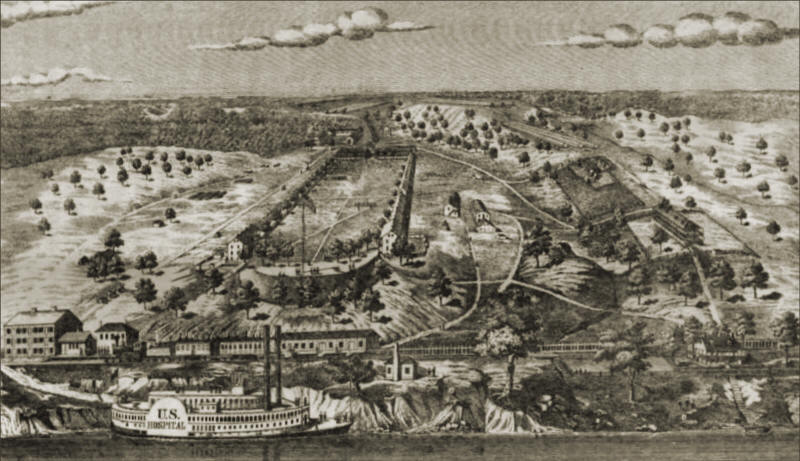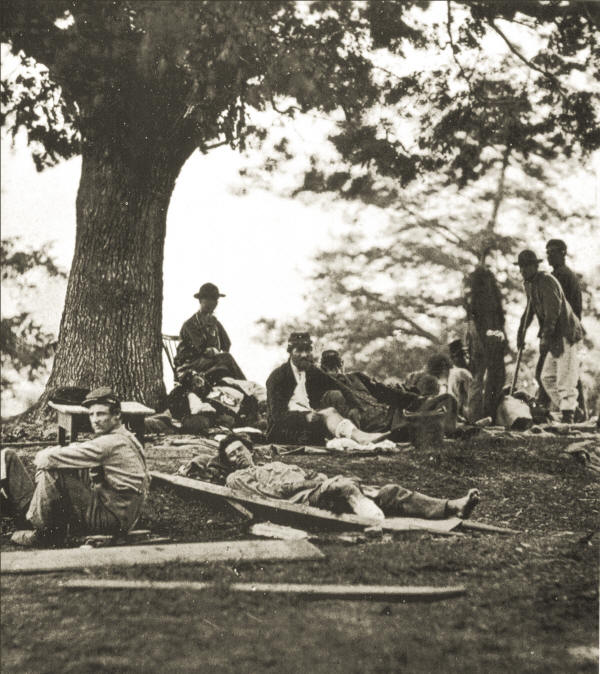Bio: Bacon, Charles G.
Contact: Stan
----Source: Local History & Research by Clark Co., WI History Buffs
Surnames:
Charles G. Bacon Neillsville, Clark
Co., Wisconsin
Jefferson Barracks,
St. Louis, Missouri, at the time
of the Civil War
Jefferson
Barracks was formerly a military post where United States troops were
stationed. It was situated about twelve miles south of St. Louis, on the west bank of the
Mississippi river. It consisted of long rows of buildings, one and two stories
high, with basement kitchens and dining-rooms, and wide piazzas, extending on
three sides of a large plat of ground, in the form of a parallelogram. It
was heavily shaded
with fine trees, the open end of the grounds bordered the river, with a
high flag-staff on the bluff. The Union flag was always
unfurled to the breeze. The old post hospital stood two stories high, and the post chapel
was situated several
hundred yards back from the river. In April,
1862, these buildings, except the post Chapel, which was still reserved for
worship, were converted into a large hospital. They were well suited for
the purpose, the rooms being large, having numerous windows on both sides,
opposite each other and offering excellent
opportunities for exercise. Beside the
existing buildings, others were erected during the summer of 1862 and the entire
complex could accommodated two thousand five hundred patients. The new buildings are one story high,
in triple rows six hundred feet long, divided into wards of three hundred feet
each. There were three sets of these new hospitals, some distance
apart, the entire grounds in every direction being beautifully shaded by large
oak trees. They were so arranged that each group had the central row
appropriated to a dining-room, and surgeons, nurses' and stewards' quarters.
The
outside rows were the sick wards. Besides these changes, a water
works system was also added, with reservoir and pipes which carried the water of the
Mississippi through all the buildings. The
institution was in charge of Surgeon J. F. Randolph, U.S.A., assisted by Dr. H.
R. Tilton, U.S.A., and P.C. McLane, M.D.; A. L. Allen, M.D.; T. F. Rumbold,
M.D.; Hiram Latham, M.D.; S. Leslie, M.D.; and J. J. Marston, M.D. Post
Chaplain, Rev. J. F. Fish, was also stationed there for many years, and
served in connection with Rev. S. Pettigrew, the Hospital Chaplain. 11,434 patients
were received and treated in this hospital in a two year time period, ending April 30,
1864. The first year was eleven and a half percent of the patients died.
That increased dramatically when large numbers of wounded soldier were admitted in a dying
condition. The percentage of deaths for the previous year (1863) was nine and
eight-tenths.
The Sick, dying and Wounded All Civil
War Medics were labeled Surgeons, even if they never once used a scalpel.
They did the best they could in impossible situations and their dismal record of
success is proof of their over-whelming task. More soldiers died of
illness than from enemy fire. Today we know Yellow Fever is transmitted by
mosquitoes, but the physicians of that time attributed it to other causes.
A confederate physician actually shipped the clothing worn by victims of the
fever to the northern cities in an attempt to spread the disease to the union
towns. Even Lincoln was scheduled to receive "infected" shirts in hopes
that he too would succumb to the fever. It has also been said that as many
soldiers were claimed by dysentery as were killed by guns. In the
beginning days of the war, even plaques of measles caused battles to be
postponed.
The Dying Tree
Both sides picked out a "Dying Tree" close
to nearly every major battlefield.
The mortally wounded were
taken there to spend the last moments of their life. The most
common operation by the Field Hospital surgeons was Amputation performed with no
attempt at sanitization. Heaps of arms and legs were a common site at the
field hospitals and the dreadful repetitive sound of the bone saws and the
groans of the patients were all too familiar to the ambulance crews.
Occasionally, Opium was used as a pain killer and many of the wounded became
addicted to it. The most unfortunate soldier received no pain killers
before their limb was removed because supplies were always low. Even if
the wounded and sick survived the field hospitals, as Charles G. Bacon did, they
were taken to general hospitals, such as Jefferson Barracks, where gangrene and
a wide range of infections were apt to take their last threads of life before
their mutilated bodies were shipped back to their grieving families. © Every submission is protected by the Digital Millennium Copyright Act
of 1998. Show your appreciation of this freely provided information by not
copying it to any other site without our
permission.
Become a Clark County History
Buff
A site created and
maintained by the Clark County History Buffs
Webmasters: Leon
Konieczny, Tanya Paschke,
Janet & Stan Schwarze, James W. Sternitzky, 


and supported by your generous donations.